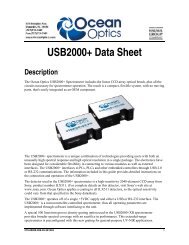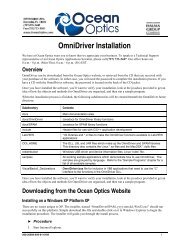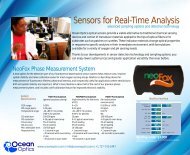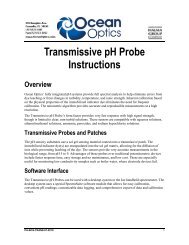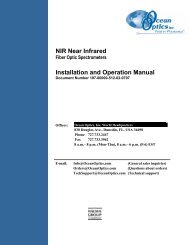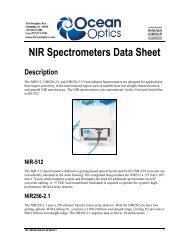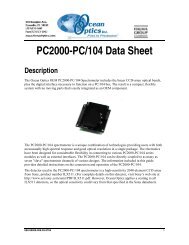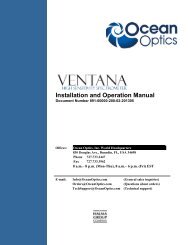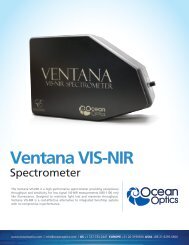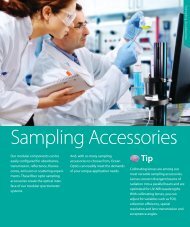Fibers and Probes - Ocean Optics
Fibers and Probes - Ocean Optics
Fibers and Probes - Ocean Optics
Create successful ePaper yourself
Turn your PDF publications into a flip-book with our unique Google optimized e-Paper software.
<strong>Fibers</strong> <strong>and</strong> <strong>Probes</strong><br />
<strong>Ocean</strong> <strong>Optics</strong> provides the most<br />
flexible line of optical fibers available.<br />
We craft our st<strong>and</strong>ard <strong>and</strong> custom<br />
fiber assemblies to provide you years<br />
of reliable, accurate results. You can<br />
depend on <strong>Ocean</strong> <strong>Optics</strong> for<br />
everything from one-off patch cords<br />
<strong>and</strong> custom assemblies to OEM<br />
builds for virtually any application<br />
you can imagine.<br />
Our fiber accessories, fixtures <strong>and</strong><br />
fiber assembly kits allow you to easily<br />
connect or manipulate fibers <strong>and</strong><br />
integrate them into the most<br />
challenging application setups.<br />
Tip<br />
To get the most from your <strong>Ocean</strong><br />
<strong>Optics</strong> optical fiber, it’s important to<br />
use special care in h<strong>and</strong>ling. Never<br />
bend or wind fibers tightly <strong>and</strong> al-<br />
ways store in a cool, dry place.<br />
<strong>Fibers</strong> <strong>and</strong> <strong>Probes</strong>
<strong>Fibers</strong> <strong>and</strong> <strong>Probes</strong><br />
<strong>Fibers</strong> <strong>and</strong> <strong>Probes</strong><br />
The Most Flexible Line in the Industry<br />
Anatomy of an Assembly Assembly Identifiers<br />
At the fiber’s core is pure silica; it’s the diameter of the core that you<br />
need to consider when purchasing an optical fiber assembly.<br />
(The core diameter is often in the product’s item code. For example,<br />
the QP600-UV-VIS has a 600 µm diameter silica core).<br />
Surrounding the core is a doped-fluorine silica cladding. A buffer<br />
material is then applied. A buffer coats the core <strong>and</strong> cladding ,<br />
strengthens the fiber <strong>and</strong> reduces stray light even further. In most<br />
assemblies polyimide is used as the buffer; other assemblies use<br />
aluminum or acrylate. Then a jacketing is applied over the core,<br />
cladding <strong>and</strong> buffer to protect the fiber <strong>and</strong> provide strain relief.<br />
For off-the-shelf Premium-grade “Q” Optical Fiber Assemblies, the<br />
st<strong>and</strong>ard jacketing is stainless steel silicone monocoil. There are<br />
several other jacketing options when creating a custom assembly.<br />
Precision SMA 905 Connectors terminate the assembly <strong>and</strong> are<br />
precisely aligned to the spectrometer’s slit to ensure concentricity<br />
of the fiber. Finally, captive end caps protect the fiber tips against<br />
scratches <strong>and</strong> contaminants.<br />
Boot<br />
Color Fiber Type<br />
Gray UV-VIS XSR Solarization-resistant 180-800 nm<br />
Gray UV/SR-VIS High OH content 200-1100 nm<br />
Blue UV-VIS High OH content 300-1100 nm<br />
Red VIS-NIR Low OH content 400-2100 nm<br />
Black Fluoride 300-4500 nm<br />
2 www.oceanoptics.com Tel: +1 727-733-2447<br />
Our optical fiber <strong>and</strong> probe assemblies are clearly <strong>and</strong> cleanly labeled in<br />
three ways so that you always know the following about your assembly: its<br />
name, its core diameter, <strong>and</strong> its most efficient wavelength region.<br />
The BOOT COLLAR color<br />
corresponds to the assembly’s<br />
fiber type (<strong>and</strong> its most<br />
efficient wavelength range).<br />
8 µm<br />
50 µm<br />
100 µm<br />
200 µm<br />
300 µm<br />
400 µm<br />
500 µm<br />
600 µm<br />
1000 µm<br />
The BAND COLOR<br />
signals the diameter of<br />
the assembly’s core.<br />
Purple<br />
Blue<br />
Green<br />
Yellow<br />
Gray<br />
Red<br />
Orange<br />
Brown<br />
Clear<br />
A WHITE PRODUCT LABEL<br />
on an assembly includes the<br />
product name <strong>and</strong> item code.<br />
B<strong>and</strong> Colors<br />
The assembly’s b<strong>and</strong> color lets you know the fiber type <strong>and</strong> the most<br />
efficient wavelength range in which your fiber will work.<br />
A color b<strong>and</strong> tells you the diameter fiber with which you are working.<br />
Most Efficient<br />
Wavelength Range Premium-grade Optical Fiber Assembly for each Fiber Type<br />
Note: An additional option for mid-IR wavelengths (2000-6000 nm) is Chalcogenide fiber. St<strong>and</strong>ard assemblies are available.
<strong>Fibers</strong> <strong>and</strong> <strong>Probes</strong>: Overview<br />
St<strong>and</strong>ard Assemblies <strong>and</strong> <strong>Probes</strong><br />
From these half-dozen st<strong>and</strong>ard fiber designs, you can tackle an extensive range of absorbance, emission <strong>and</strong> reflectance spectroscopy needs.<br />
All <strong>Ocean</strong> <strong>Optics</strong> fibers have SMA 905 terminations for connecting to our spectrometers <strong>and</strong> accessories. Custom configurations, multiple-fiber<br />
bundles <strong>and</strong> special ferrule designs are also available.<br />
Premium Patch Fiber Cord BX <strong>and</strong> Assemblies St<strong>and</strong>ard Jackets<br />
oceanoptics.com oceanoptics.com<br />
oceanoptics.com oceanoptics.com<br />
Our patch cord assemblies consist of a single fiber. Our st<strong>and</strong>ard,<br />
premium-grade options are available with stainless steel BX (top drawing)<br />
or silicone monocoil jacketing <strong>and</strong> PVDF.<br />
Bifurcated Fiber<br />
Bifurcated Fiber<br />
Bifurcated assemblies have two fibers side-by-side in the common end <strong>and</strong><br />
break out into two legs at the other end. Each leg can be UV-VIS or VIS-NIR<br />
or mixed.<br />
Transmission Dip Probe<br />
oceanoptics.com<br />
Splitter<br />
oceanoptics.com<br />
oceanoptics.com<br />
We offer several versions of this st<strong>and</strong>ard two-fiber transmission probe,<br />
designed for immersion in process streams <strong>and</strong> solutions. Various<br />
pathlength tips are available.<br />
Round to Keyed Linear Fiber<br />
727-733-2447 727-733-2447<br />
At one end of this seven-fiber assembly, the fibers are aligned linearly to<br />
more efficiently direct Bifurcated light into the optical Fiber bench <strong>and</strong> onto the detector.<br />
The collection end of the fiber has a six fibers-around-one design.<br />
Splitter<br />
Splitter<br />
A splitter comprises three fibers – two fibers at one end that deliver light<br />
into the third fiber at the common end. All the fibers are epoxied together<br />
at the nexus of the assembly.<br />
Premium Re�ection Reflection Probe Probe<br />
oceanoptics.com<br />
oceanoptics.com<br />
oceanoptics.com<br />
Our st<strong>and</strong>ard reflection probe arrangement has seven optical fibers – six<br />
illumination fibers around one read fiber – in a stainless steel ferrule.<br />
Additional configurations are available.<br />
www.oceanoptics.com Tel: +1 727-733-2447 3<br />
<strong>Fibers</strong> <strong>and</strong> <strong>Probes</strong>
<strong>Fibers</strong> <strong>and</strong> <strong>Probes</strong><br />
<strong>Fibers</strong> <strong>and</strong> <strong>Probes</strong>: Overview<br />
Transmission Characteristics of UV-VIS Options<br />
<strong>Ocean</strong> <strong>Optics</strong> offers fiber material types with wavelength ranges to best match your application. On these pages are the attenuation curves for each<br />
of the fiber types we offer. High OH, or high water content fiber, is optimized for transmission in the UV-VIS. For work in the UV, especially
ATTENUATION (dB/m)<br />
3<br />
2.5<br />
2<br />
1.5<br />
1<br />
0.5<br />
0<br />
Fluoride: 300-4500 nm<br />
0 500 1000 1500 2000 2500 3000 3500 4000 4500<br />
WAVELENGTH (nm)<br />
<strong>Fibers</strong> <strong>and</strong> <strong>Probes</strong>: Overview<br />
Transmission Characteristics of VIS-NIR <strong>and</strong> Mid-IR Options<br />
<strong>Ocean</strong> <strong>Optics</strong> offers several options for applications at higher wavelengths. For most Visible <strong>and</strong> Shortwave NIR setups, our low OH VIS-NIR fibers are<br />
a convenient, affordable option. If your work takes you farther into the NIR <strong>and</strong> mid-IR, consider our fluoride <strong>and</strong> chalcogenide fiber options. ZBLAN<br />
heavy-metal fluoride fibers are responsive to 4500 nm <strong>and</strong> distinguished by excellent IR transmittance performance. Chalcogenide fibers are responsive<br />
from 2000-6000 nm <strong>and</strong> characterized by low optical loss <strong>and</strong> great flexibility.<br />
ATTENUATION (dB/m)<br />
ATTENUATION (dB/km)<br />
1000<br />
VIS-NIR Low OH <strong>Fibers</strong>: 400-2100 nm<br />
2.0<br />
1.8<br />
1.6<br />
1.4<br />
1.2<br />
1.0<br />
0.8<br />
0.6<br />
0.4<br />
0.2<br />
800<br />
600<br />
400<br />
200<br />
0<br />
300 500 700 900 1100 1300 1500 1700 1900 2100 2300 2500<br />
WAVELENGTH (nm)<br />
Chalcogenide: 2000-6000 nm<br />
0<br />
2000 2500 3000 3500 4000 4500 5000 5500 6000<br />
WAVELENGTH (nm)<br />
Numerical Aperture of Optical <strong>Fibers</strong><br />
Optical fibers are designed to transmit light from one end of the fiber to the<br />
other with minimal loss of energy. The principle of operation in an optical fiber<br />
is total internal reflection. When light passes from one material to another,<br />
its direction is changed. According to Snell’s Law, the new angle of the light<br />
ray can be predicted from the refractive indices of the two materials. When<br />
the angle is perpendicular (90º) to the interface, transmission into the second<br />
material is maximum <strong>and</strong> reflection is minimum. Reflection increases as the<br />
angle gets closer to parallel to the interface. At the critical angle <strong>and</strong> below the<br />
critical angle, transmission is 0% <strong>and</strong> reflection is 100% (see figure below).<br />
oceanoptics.com<br />
Snell’s Law can be formulated to predict critical angle <strong>and</strong> also the launch or<br />
exit angle θ from the index of refraction of the core (n1) <strong>and</strong> cladding (n2)<br />
max<br />
Cladding<br />
materials. The angle also depends on the refractive index of the media (n).<br />
Equation (1)<br />
oceanoptics.com<br />
Light Passing Through an Optical Fiber<br />
Cladding<br />
r oceanoptics.com<br />
90 - 0c<br />
n sin θ = √n 2 – n<br />
max<br />
90 - 0c<br />
0c 0c<br />
0c<br />
oceanoptics.com<br />
The left side of the equation is called the numerical aperture (NA) <strong>and</strong><br />
determines the range of angles at which the fiber can accept or emit light.<br />
<strong>Ocean</strong> <strong>Optics</strong> fibers have a numerical aperture of 0.22. If the fiber is in a<br />
vacuum or air, this translates into an acceptance angle θ max of 12.7° (full angle<br />
is ~25°). When light is directed at the end of an optical fiber all the light rays or<br />
trajectories that are within the +/-12.7° cone are propagated down the length<br />
of the fiber by total internal reflection. All the rays that exceed that angle pass<br />
through the cladding <strong>and</strong> are lost. At the other end of the fiber, light exits in a<br />
cone that is +/- 12.7°.<br />
There are many types of fibers available, with a variety of numerical apertures.<br />
While a fiber with a larger numerical aperture will collect more light than a<br />
fiber with a smaller numerical aperture, it is important to look at both ends of<br />
the system to ensure that light exiting at a higher angle can be used. In optical<br />
sensing, one end is gathering light from an experiment <strong>and</strong> the other is<br />
directing light to a detector. Any light that does not reach the detector will be<br />
wasted.<br />
1<br />
2<br />
2<br />
Core<br />
Core<br />
www.oceanoptics.com Tel: +1 727-733-2447 5<br />
<strong>Fibers</strong> <strong>and</strong> <strong>Probes</strong>
<strong>Fibers</strong> <strong>and</strong> <strong>Probes</strong><br />
Premium Grade Optical Fiber Assemblies<br />
Our premium-grade fibers are durable, high quality fibers optimized for spectroscopy <strong>and</strong> enhanced with extra strain relief for use even in dem<strong>and</strong>ing<br />
environments. We have a full range of st<strong>and</strong>ard patch cords <strong>and</strong> can customize assemblies (see pages 138-139 for options). Also available are assemblies<br />
(see table at bottom) consisting of multiple fibers stacked in a linear arrangement at one end to deliver light more efficiently into the spectrometer.<br />
Premium-Grade Assemblies Assembly Length Jacketing Bend Radius<br />
Wavelength<br />
Range Item Code<br />
UV-VIS High<br />
OH Content<br />
300-1100 nm<br />
VIS-NIR Low<br />
OH content<br />
400-2100 nm<br />
QP50-2-UV-VIS<br />
QP50-2-UV-BX<br />
QP100-2-UV-VIS<br />
QP100-2-UV-BX<br />
QP200-2-UV-VIS<br />
QP200-2-UV-BX<br />
QP400-1-UV-VIS<br />
QP400-1-UV-BX<br />
QP400-2-UV-VIS<br />
QP400-2-UV-BX<br />
QP600-025-UV-VIS<br />
QP600-025-UV-BX<br />
QP600-1-UV-VIS<br />
QP600-1-UV-BX<br />
QP600-2-UV-VIS<br />
QP600-2-UV-BX<br />
Keyed SMA Optical Fiber Assemblies<br />
Note: Fiber bend radius is expressed as Long Term (LTBR) <strong>and</strong> Short Term (STBR).<br />
6 www.oceanoptics.com Tel: +1 727-733-2447<br />
Core<br />
Diameter Buffer/<br />
Coating 0.25 m 0.5 m 1 m 1.5 m 2 m Silicone<br />
monocoil Stainlesssteel<br />
BX<br />
50 µm Polyimide X X<br />
100 µm Polyimide X X<br />
200 µm Polyimide X X<br />
400 µm Polyimide X X<br />
600 µm Polyimide X X<br />
QP1000-2-UV-VIS<br />
QP1000-2-VIS-BX 1000 µm Acrylate X X<br />
X<br />
X<br />
X<br />
X<br />
X<br />
X<br />
X<br />
X<br />
X<br />
X<br />
X<br />
X<br />
X<br />
X<br />
X<br />
X<br />
X<br />
X<br />
X<br />
X<br />
X<br />
PVDF<br />
Furcation PEEK LTBR STBR<br />
4 cm 2 cm<br />
4 cm 2 cm<br />
8 cm 4 cm<br />
16 cm 8 cm<br />
24 cm 12 cm<br />
40 cm 20 cm<br />
QP8-2-VIS-NIR 8 µm Acrylate X X 4 cm 2 cm<br />
QP50-2-VIS-NIR<br />
QP50-2-VIS-BX<br />
QP100-2-VIS-NIR<br />
QP100-2-VIS-BX<br />
QP200-2-VIS-NIR<br />
QP200-2-VIS-BX<br />
QP400-1-VIS-NIR<br />
QP400-1-VIS-BX<br />
QP400-2-VIS-NIR<br />
QP400-2-VIS-BX<br />
QP600-025-VIS-NIR<br />
QP600-025-VIS-BX<br />
QP600-1-VIS-NIR<br />
QP600-1-VIS-BX<br />
QP600-2-VIS-NIR<br />
QP600-2-VIS-BX<br />
50 µm Polyimide X X<br />
100 µm Polyimide X X<br />
200 µm Polyimide X X<br />
400 µm Polyimide X X<br />
600 µm Polyimide X X<br />
QP1000-2-VIS-NIR<br />
QP1000-2-VIS-BX 1000 µm Acrylate X X<br />
Fluoride<br />
300-4500 nm P450-0.5-FLUORIDE<br />
P450-1.5-FLUORIDE<br />
P450-1-FLUORIDE<br />
Chalcogenide<br />
2000-<br />
6000 nm<br />
P500-0.5-CHAL<br />
P500-1-CHAL<br />
450 µm Acrylate X<br />
500 µm Fluoropolymer<br />
<strong>and</strong><br />
PVC<br />
Keyed SMA Optical Fiber Assemblies,<br />
Round to Keyed Linear Assembly Length Jacketing<br />
Wavelength<br />
Range Item Code<br />
Core<br />
Diameter<br />
X<br />
X<br />
X<br />
X<br />
X<br />
X<br />
X<br />
Buffer/<br />
Coating 0.25 m 0.5 m 1 m 1.5 m 2 m<br />
X<br />
X<br />
X<br />
X<br />
X<br />
X<br />
X<br />
X<br />
X<br />
X<br />
X<br />
X<br />
Silicone<br />
monocoil<br />
X<br />
X<br />
X<br />
X<br />
X<br />
X<br />
X<br />
X<br />
X<br />
Stainlesssteel<br />
BX<br />
X<br />
X<br />
X<br />
X X<br />
4 cm 2 cm<br />
4 cm 2 cm<br />
8 cm 4 cm<br />
16 cm 8 cm<br />
24 cm 12 cm<br />
40 cm 20 cm<br />
15 cm 8 cm<br />
7.5<br />
cm<br />
7.5<br />
cm<br />
PVDF<br />
Furcation PEEK LTBR STBR<br />
300-1100 nm PL100-2-UV-VIS 100 µm ± 3 µm Polyimide x x 4 cm 2 cm<br />
400-2100 nm PL100-2-VIS-NIR 100 µm ± 3 µm Polyimide x x 4 cm 2 cm<br />
300-1100 nm <strong>and</strong> PL100-2-MIXED 100 µm ± 3 µm Polyimide x x<br />
4 cm 2 cm<br />
400-2100 nm<br />
x x<br />
300-1100nm <strong>and</strong><br />
400-2100 nm<br />
PL200-2-MIXED 200 µm ± 4 µm Polyimide x x 8 cm 4 cm
Bifurcated Optical Fiber Assemblies<br />
Premium-grade bifurcated assemblies have two fibers in the common end of the assembly that break out into separate legs. Splitters comprise three<br />
fibers epoxied at the nexus of a Y-shaped assembly <strong>and</strong> have lower transmission efficiency than bifurcated fibers.<br />
Premium-grade Bifurcated Optical Fiber Assemblies<br />
Wavelength Range Item Code Core Diameter<br />
VIS-NIR Low OH<br />
content 400-2100 nm<br />
UV-VIS High OH<br />
Content 300-1100 nm<br />
300-1100 nm <strong>and</strong><br />
400-2100 nm (Mixed)<br />
Buffer/<br />
Coating 2 m<br />
Assembly<br />
Length Jacketing<br />
QBIF50-VIS-NIR 50 µm Polyimide X X<br />
QBIF200-VIS-NIR<br />
QBIF200-NIR-BX<br />
QBIF400-VIS-NIR<br />
QBIF400-NIR-BX<br />
QBIF600-VIS-NIR<br />
QBIF600-NIR-BX<br />
200 µm Polyimide X X<br />
400 µm Polyimide X X<br />
600 µm Polyimide X X<br />
Silicone<br />
monocoil<br />
Bend<br />
Radius<br />
Stainlesssteel<br />
BX LTBR STBR<br />
We offer two types of solarization-resistant fiber assemblies, which prevent transmission degradation in the UV: polyimide-buffer fibers for applications<br />
<strong>Fibers</strong> <strong>and</strong> <strong>Probes</strong><br />
<strong>Fibers</strong> <strong>and</strong> <strong>Probes</strong><br />
Custom Fiber <strong>and</strong> Probe Assemblies<br />
Custom <strong>Fibers</strong><br />
After selecting the best fiber type, you should consider the diameter size of the pure silica core needed inside of your assembly. We offer several<br />
diameter sizes, <strong>and</strong> can recommend the appropriate assembly based on these criteria:<br />
1. How much light do you need for your application? Reflection <strong>and</strong> fluorescence applications generally need more light, <strong>and</strong> larger diameter<br />
fibers are often better choices than smaller diameter fibers. For a laser application, however, we may suggest a smaller diameter fiber.<br />
2. What is the entrance aperture size of your spectrometer? Make sure that your fiber diameter size <strong>and</strong> the entrance aperture to your<br />
spectrometer are compatible <strong>and</strong> are configured properly for your application needs.<br />
3. If you have too much light in your setup, are there ways you can attenuate the light? We believe that it’s better to have too much light than not<br />
enough.<br />
8 www.oceanoptics.com Tel: +1 727-733-2447
<strong>Fibers</strong> <strong>and</strong> <strong>Probes</strong><br />
Custom Fiber <strong>and</strong> Probe Assemblies<br />
Custom Option: Jacketing Options<br />
The fiber assembly jacketing is designed to protect the fiber <strong>and</strong> provide strain relief. But we have jacketing options that can do so much more. We<br />
offer multiple jacketing options; our most popular selections are listed below.<br />
1 2 3 4 5 6<br />
Chemical Steam Mechanical Length<br />
Item Description<br />
Resistance Sterilizable Tolerance Limits<br />
1 PVC Monocoil PVC covering SS monocoil only Poor No Good 6 m<br />
2 Zip Tube Blue PVDF Best for budget-conscious applications; st<strong>and</strong>ard in<br />
Laboratory-grade Assemblies<br />
Poor No Good 50 m<br />
3 Zip Tube Blue PVDF Best for budget-conscious applications; larger<br />
diameter than #2<br />
Poor No Good 50 m<br />
4 Silicone Monocoil High-end jacketing; st<strong>and</strong>ard in Premium-grade<br />
Assemblies (sIlicone covering SS monocoil)<br />
Good Yes Good 20 m<br />
5 Stainless-steel BX OEM applications only; optional polyolefin<br />
heatshrink overcoat<br />
Good Yes Poor 4 m<br />
6 Stainless-steel<br />
Excellent stainless steel jacketing supports longer Good Yes Excellent 40 m<br />
fully interlocked BX lengths of fiber; optional polyolefin heatshrink<br />
overcoat<br />
Custom Option: Connectors <strong>and</strong> Connector Adapters<br />
Our fiber assemblies are available with several connector options. For an upgrade fee that includes the cost of the custom connector <strong>and</strong> labor,<br />
we will replace the st<strong>and</strong>ard SMA 905 Connector (included in the assembly price) with any custom connector from the list below. When ordering<br />
custom connectors, please specify the diameter size of the optical fiber to which it will be attached. You also can order connectors separately.<br />
Item Description<br />
CONN-ST Stainless-steel ST Connector<br />
CONN-FC Stainless-steel FC Connector<br />
CONN-QSMA Premium-grade SMA 905 Connector (st<strong>and</strong>ard in Premium-grade assemblies)<br />
CONN-SMA Laboratory-grade SMA 905 Connector (st<strong>and</strong>ard in Laboratory-grade assemblies)<br />
CONN-QSMA-O Premium-grade SMA 905 Connector with O-ring<br />
CONN-SMA-O Laboratory-grade SMA 905 Connector with O-ring<br />
Custom Option: Ferrules for Probe Assemblies<br />
Description Length<br />
1/4” (6.35 mm) diameter stainless-steel dip probe often used in solution transmission measurements 3” (76.2 mm)<br />
1/4” (6.35 mm) diameter PEEK dip probe used in harsh environments for solution transmission<br />
measurements<br />
3” (76.2 mm)<br />
1/4” (6.35 mm) diameter stainless-steel ferrule used in reflection measurements 3” (76.2 mm)<br />
1/4” (6.35 mm) diameter PEEK ferrule used in harsh environments 3” (76.2 mm)<br />
1/8” (3.2 mm) diameter stainless-steel ferrule 3” (76.2 mm)<br />
1/16” (1.59 mm) diameter stainless-steel ferrule 2” (51 mm)<br />
1/4” (6.35 mm) diameter stainless-steel ferrule with angled window 2” (51 mm)<br />
Fiber-to-lens ferrule that comes with a collimating lens 2” (51 mm)<br />
CONN-QSMA<br />
CONN-SMA<br />
Stainless steel or<br />
PEEK sleeve<br />
Stainless steel<br />
for reflection<br />
Stainless steel<br />
www.oceanoptics.com Tel: +1 727-733-2447 9<br />
<strong>Fibers</strong> <strong>and</strong> <strong>Probes</strong>
<strong>Fibers</strong> <strong>and</strong> <strong>Probes</strong><br />
Reflection/Backscattering <strong>Probes</strong><br />
Our Reflection <strong>Probes</strong> are ideal for measuring diffuse or specular reflectance from solid surfaces or backscattering <strong>and</strong> fluorescence in solutions <strong>and</strong><br />
powders. <strong>Probes</strong> are available in lab-grade (R-series) <strong>and</strong> premium-grade (QR-series) versions. Choose from nearly 40 st<strong>and</strong>ard options or customize<br />
a probe by selecting different lengths <strong>and</strong> other features.<br />
St<strong>and</strong>ard Reflection/Backscattering <strong>Probes</strong> Fiber Bundle Probe Ferrule Jacketing<br />
Wavelength<br />
Range Item Code<br />
VIS-NIR Low<br />
OH content<br />
400-2100 nm<br />
UV-VIS High<br />
OH Content<br />
300-1100 nm<br />
UV/SR-VIS<br />
High OH content<br />
200-1100 nm<br />
UV-VIS XSR<br />
Solarizationresistant<br />
180-900 nm<br />
QR200-7-VIS-NIR<br />
R200-7-VIS-NIR<br />
QR400-7-VIS-NIR<br />
R400-7-VIS-NIR<br />
QR400-7-VIS-BX<br />
R400-7-VIS-BX<br />
QR600-7-VIS-NIR<br />
R600-7-VIS-125F<br />
QR600-7-VIS-125F<br />
QR600-7-VIS125BX<br />
QR200-7-UV-VIS<br />
R200-7-UV-VIS<br />
QR400-7-UV-VIS<br />
R400-7-UV-VIS<br />
QR400-7-VIS-BX<br />
R400-7-VIS-BX<br />
QR400-7-UV-BX<br />
QR600-7-UV-VIS<br />
R600-7-UV-125F<br />
QR600-7-UV-125F<br />
QR600-7-UV125BX<br />
QR200-7-SR<br />
R200-7-SR<br />
QR300-7-SR<br />
R300-7-SR<br />
QR400-7-SR<br />
R400-7-SR<br />
QR400-7-SR-BX<br />
R400-7-SR-BX<br />
QR600-7-SR-125F<br />
R600-7-UV-125F<br />
QR600-7-SR125BX<br />
R600-7-SR-125F<br />
QR600-7-UV-125F<br />
QR600-7-UV125BX<br />
QR600-7-VIS-125F<br />
QR600-7-VIS-125BX<br />
Core<br />
Diameter<br />
200 µm X X<br />
400 µm X XXX<br />
600 µm X XXX<br />
200 µm X X<br />
400 µm X XXXX<br />
600 µm X XXX<br />
200 µm X X<br />
300 µm X X<br />
400 µm X XXX<br />
600 µm X XXXXXXX<br />
6 illumination<br />
fibers around<br />
1 read fiber<br />
Our most typical reflection probe design has a tightly packed<br />
6-around-1 fiber bundle to ensure parallel orientation of the fibers.<br />
Reflection probes couple to our spectrometers<br />
<strong>and</strong> light sources to measure<br />
reflection <strong>and</strong> fluorescence from<br />
solid surfaces or backscattering <strong>and</strong><br />
fluorescence in liquids <strong>and</strong> powders.<br />
Sample applications include color <strong>and</strong><br />
appearance measurements of solid<br />
surfaces such as filters <strong>and</strong> biological<br />
samples <strong>and</strong> backscattering measurements<br />
of milk, bulk powders <strong>and</strong> dyes.<br />
Also, we offer a 200 µm reflection probe in the same 6-around-1<br />
design, but with a 76.2 mm PEEK ferrule for applications (such as corrosive<br />
environments) where non-metallic probes are necessary.<br />
Item Code: RP200-7-UV-VIS<br />
6.35 mm<br />
OD x<br />
76.2 mm<br />
X<br />
X<br />
X<br />
X<br />
X<br />
X<br />
X<br />
X<br />
X<br />
X<br />
X<br />
X<br />
X<br />
X<br />
X<br />
X<br />
X<br />
X<br />
X<br />
X<br />
X<br />
X<br />
X<br />
X<br />
X<br />
X<br />
3.18 mm<br />
OD x<br />
74.3 mm Silicone<br />
monocoil<br />
X<br />
X<br />
X<br />
X<br />
X<br />
X<br />
X<br />
X<br />
X<br />
X<br />
X<br />
X<br />
X<br />
X<br />
X<br />
Stainlesssteel<br />
BX<br />
X<br />
X<br />
X<br />
Zip tube<br />
blue<br />
PVDF LTBR STBR<br />
X<br />
X<br />
X<br />
X X<br />
X<br />
X<br />
X<br />
X<br />
X<br />
X<br />
X<br />
X<br />
X<br />
X<br />
X<br />
X<br />
X<br />
X<br />
X<br />
X<br />
X<br />
X<br />
X<br />
X<br />
X<br />
X<br />
X<br />
X<br />
X<br />
8 cm 4 cm<br />
16 cm 8 cm<br />
24 cm 12 cm<br />
8 cm 4 cm<br />
16 cm 8 cm<br />
24 cm 12 cm<br />
8 cm 2 cm<br />
12 cm 6 cm<br />
16 cm 8 cm<br />
24 cm 12 cm<br />
QR230-7-XSR 230 µm X X X 4.6 cm 2.3 cm<br />
QR450-7-XSR 450 µm X X X 9.0 cm 4.5 cm<br />
10 www.oceanoptics.com Tel: +1 727-733-2447
Reflection/Backscattering <strong>Probes</strong><br />
Reflection <strong>Probes</strong> with Reference Leg Fiber Bundle Probe Ferrule Jacketing<br />
Wavelength<br />
Range Item Code<br />
VIS-NIR Low<br />
OH content<br />
400-2100 nm<br />
UV-VIS High<br />
OH Content<br />
300-1100 nm<br />
QR200-7-REF-VIS-NIR<br />
R200-7-REF-VIS-NIR<br />
QR200-7-REF-UV-VIS<br />
R200-7-REF-UV-VIS<br />
Core<br />
Diameter<br />
200 µm X<br />
X<br />
200 µm X<br />
X<br />
6 illumination fibers<br />
around 1 read<br />
Reflection/Backscattering <strong>Probes</strong> for Exp<strong>and</strong>ed Wavelength Coverage<br />
UV-VIS <strong>and</strong><br />
VIS-NIR<br />
300-1100 nm<br />
<strong>and</strong><br />
400-2100 nm<br />
QR200-12-MIXED<br />
R200-12-MIXED<br />
Angled <strong>Probes</strong> for Solutions <strong>and</strong> Powders<br />
VIS-NIR Low<br />
OH content<br />
400-2100 nm<br />
UV-VIS High<br />
OH Content<br />
300-1100 nm<br />
A<br />
QR200-7-ANGLE-VIS<br />
R200-7-ANGLE-VIS<br />
QR400-7-ANGLE-VIS<br />
R400-7-ANGLE-VIS<br />
QR400-ANGLE-VIS<br />
QR200-7-ANGLE-UV<br />
R200-7-ANGLE-UV<br />
QR400-7-ANGLE-UV<br />
R400-7-ANGLE-UV<br />
QR400-ANGLE-UV<br />
oceanoptics.com<br />
200 µm 6 UV-VIS <strong>and</strong> 6<br />
VIS-NIR illumination<br />
fibers around<br />
1 UV-VIS <strong>and</strong><br />
1 VIS-NIR fibers<br />
200 µm X<br />
X<br />
400 µm X<br />
X<br />
X<br />
200 µm X<br />
X<br />
400 µm X<br />
X<br />
X<br />
6.35 mm<br />
OD<br />
X<br />
X<br />
X<br />
X<br />
X<br />
X<br />
X<br />
X<br />
3.18 mm<br />
OD<br />
Silicone<br />
monocoil<br />
X<br />
Reflection/Backscattering <strong>Probes</strong> for Exp<strong>and</strong>ed Wavelength Coverage<br />
oceanoptics.com<br />
oceanoptics.com<br />
X<br />
X<br />
X<br />
X<br />
X<br />
X<br />
X<br />
X<br />
X<br />
X<br />
X<br />
X<br />
X<br />
X<br />
X<br />
X<br />
Zip tube blue<br />
PVDF LTBR STBR<br />
X<br />
8 cm 4 cm<br />
X<br />
X<br />
X<br />
X<br />
X<br />
X<br />
8 cm 4 cm<br />
8 cm 4 cm<br />
8 cm 4 cm<br />
16 cm 8 cm<br />
8 cm 4 cm<br />
16 cm 8 cm<br />
The QR200-12-MIXED has 14 fibers -- six UV-VIS <strong>and</strong> six VIS-NIR illumination fibers, plus one UV-VIS <strong>and</strong> one VIS-NIR read<br />
fiber (see bundle photo at left). It couples easily to a dual-channel spectrometer in which each channel is set for a different<br />
wavelength range.<br />
Item Code: QR200-12-MIXED<br />
Angled Reflection Probe<br />
A = Read Fiber<br />
B = Dummy Fiber<br />
Our Angled Reflection <strong>Probes</strong> have a 6-around-1 fiber design with a 30º window<br />
to remove specular effects when the probe is immersed in liquids or powders.<br />
A<br />
B<br />
A<br />
Reflection Probe With Reference Leg<br />
oceanoptics.com<br />
B<br />
A = Read Fiber<br />
B = Reference Fiber<br />
oceanoptics.com<br />
oceanoptics.com<br />
In this design, an additional fiber leg is added to the probe to monitor an<br />
illumination or reference source. This is useful where the changing output of the<br />
source needs continuous monitoring.<br />
www.oceanoptics.com Tel: +1 727-733-2447 11<br />
A<br />
B<br />
<strong>Fibers</strong> <strong>and</strong> <strong>Probes</strong>
<strong>Fibers</strong> <strong>and</strong> <strong>Probes</strong><br />
FL-400<br />
Flame-resistant Fiber Probe<br />
Fiber core diameter: 400 µm<br />
Assembly length: 20 cm (8”)<br />
Fiber core/cladding: Silica<br />
Fiber core/cladding<br />
diameter:<br />
400 µm/440 µm<br />
Fiber jacketing: Gold<br />
Fiber buffer/<br />
tube diameter:<br />
510 µm/0.9 µm<br />
Fiber bundle: 1 single-str<strong>and</strong>, multi-mode read fiber<br />
Wavelengths covered: 300-1100 nm<br />
Probe sleeve (ferrule): Stainless steel<br />
Flame loop: Nickel chromium 24 AWG<br />
Temperature range: -269º C to 750º C<br />
Numerical aperture: 0.22<br />
Fiber termination: SMA 905<br />
12 www.oceanoptics.com Tel: +1 727-733-2447<br />
THAT’S HOT!<br />
The FL-400 is a heat-resistant fiber optic probe that couples to <strong>Ocean</strong> <strong>Optics</strong><br />
miniature fiber optic spectrometers to measure in situ emission spectra of<br />
samples such as dissolved metals <strong>and</strong> high-temperature plasmas.<br />
High-temperature Fiber<br />
The FL-400 Flame-resistant Fiber Probe consists of a high-temperature<br />
400 µm gold-jacketed UV-VIS optical fiber in an 8-inch-long stainless steel<br />
sleeve. The probe is connected with a splice bushing to a st<strong>and</strong>ard SMAterminated<br />
patch cord, which couples to the spectrometer to measure<br />
emission spectra.<br />
Spectroscopy Teaching Tool<br />
The FL-400 Flame-resistant Fiber Probe is especially beneficial as an emission<br />
spectroscopy teaching tool for use with <strong>Ocean</strong> <strong>Optics</strong>’ CHEM4-series<br />
of low-cost, UV-VIS teaching-lab spectrophotometers. Use the probe in two<br />
ways:<br />
- By introducing it into emission sample environments up to 750 °C<br />
- By attaching the nickel wire loop at the probe tip so that users can<br />
observe flame emission spectra of samples such as sodium, potassium,<br />
calcium <strong>and</strong> copper<br />
Item Code: FL-400<br />
H<strong>and</strong>held, modular spectrometers for irradiance measurements of solar cels <strong>and</strong> solar simulators.<br />
• Modular, miniature spectrometers that are ideal for use with<br />
solar simulators<br />
• Characterization of dye-sensitive <strong>and</strong> organic cells<br />
• Quality control of photovoltaic panels<br />
• OEM sensing systems for a variety of solar production needs<br />
Find out how <strong>Ocean</strong> <strong>Optics</strong> can help you improve quality, increase efficiency <strong>and</strong> boost profit.<br />
www.oceanoptics.com/solar.asp
Transmission Dip <strong>Probes</strong><br />
General Purpose <strong>Probes</strong> for the Lab <strong>and</strong> Other Environments<br />
Our T300-RT <strong>and</strong> T200-RT Transmission Dip <strong>Probes</strong> couple to our spectrometers <strong>and</strong> light sources to measure absorbance <strong>and</strong> transmission in<br />
solutions. These probes are especially useful for embedding into process streams for real-time sample monitoring.<br />
Item Code: T300-RT, T200-RT<br />
Item Specifications<br />
Fiber type: T300: 300 µm solarization-resistant or VIS-NIR optical<br />
fiber; T200: 200 µm VIS-NIR optical fiber<br />
Outer diameter: 6.35 mm<br />
Probe length: 127 mm<br />
Fiber length: 2 meters<br />
Breakout: 1.0 meters from the end of the probe<br />
<strong>Optics</strong>: Fused silica<br />
Probe wetted materials: Stainless steel, fused silica, Epotek 353ND<br />
Pathlength: 2, 5 or 10 mm<br />
Internal materials: Second surface aluminum mirror<br />
Fiber jacketing: PVC Monocoil - PVDF zip tube<br />
Probe sleeve: Stainless steel (300 series)<br />
Connector: SMA 905<br />
Operating temperature: Up to 100 ºC without sleeve<br />
EVAS Probe<br />
The Evanescent Wave Absorption Sensor<br />
The EVAS evanescent wave absorption sensor consists of a sapphire fiber wound<br />
around a vertical PTFE shaft. The ends of the fiber are tapered up to facilitate the<br />
coupling of light into <strong>and</strong> out of the probe. The design permits the adjustment of<br />
the interaction length by more than an order of magnitude to accommodate the<br />
optical analysis of spectral features with widely different absorption coefficients.<br />
The EVAS is especially well suited for measurements in turbid fluids.<br />
Item Code: EVAS-PROBE-50, EVAS-PROBE-65<br />
Transmitted Signal (A.U.)<br />
.030<br />
.027<br />
.024<br />
.021<br />
.018<br />
.015<br />
.012<br />
.009<br />
.006<br />
.003<br />
Water in Alcohol EVAS<br />
99.5+% Ethyl Alcohol<br />
1.5% H2O Added<br />
3.5% H2O Added<br />
5.5% H2O Added<br />
0<br />
1800 1820 1840 1860 1880 1900 1920 1940 1960 1980 2000<br />
WAVELENGTH (nm)<br />
99.5+% Ethyl Alcohol<br />
1.5% H2O Added<br />
3.5% H2O Added<br />
5.5% H2O Added<br />
www.oceanoptics.com Tel: +1 727-733-2447 13<br />
<strong>Fibers</strong> <strong>and</strong> <strong>Probes</strong>
<strong>Fibers</strong> <strong>and</strong> <strong>Probes</strong><br />
Transmission <strong>Probes</strong><br />
Transmission Dip <strong>Probes</strong> for Hostile Environments<br />
The TP300-UV-VIS Transmission Dip Probe couples to our<br />
spectrometers <strong>and</strong> light sources to measure the absorbance <strong>and</strong><br />
transmission of solutions in harsh environments.<br />
Also, the TP300-UV-VIS Probe is a chemically inert PEEK<br />
transmission probe that can be equipped with a tip (RT-PH) for<br />
mounting transmissive pH films in the optical path. Light is directed<br />
via one fiber through the mounted<br />
film to a mirror. Then light is redirected<br />
back through the film to<br />
a receive fiber that returns the<br />
light to the spectrometer.<br />
The sample is free to flow<br />
over the sides of the<br />
film.<br />
By using an<br />
RTP-2-10 (adjustable 2-10 mm)<br />
Transmission Tip, the TP300-UV-VIS can be used<br />
for routine transmission measurements.<br />
Item Code: TP300-UV-VIS<br />
Item Specifications<br />
Fiber type: TI300-UV-VIS - 300 µm diameter UV-SR fiber<br />
type (200-1100 nm)<br />
TI300-VIS/NIR - 300 µm diameter VIS-NIR fiber<br />
type (400-2100 nm)<br />
Temperature limit: 300 °C (short term); 200 °C (continuous)<br />
Sampling tip body: 316 stainless steel<br />
Sampling tip optics: Quartz back-coated mirror <strong>and</strong> quartz lens<br />
Sampling tip O-ring: Parker perfluoroelastomer (Parofluor ULTRA)<br />
O-ring seal<br />
Probe ferrule: 12.7 mm outer diameter 316 stainless steel<br />
Probe jacketing: Fully interlocked stainless-steel jacketing over<br />
Teflon tubing; total 7.0 mm outer diameter<br />
Length: Fiber – 2 meters<br />
Ferrule – 12.7 cm without tip<br />
Tips – 2.6 cm to 4.99 cm, depending on tip<br />
Breakout distance: 1 meter from the end of the probe<br />
Immersible length: 12.7 cm<br />
Optical pathlengths: 2, 5, 10, 25 <strong>and</strong> 50 mm pathlengths available<br />
Connectors: SMA 905<br />
14 www.oceanoptics.com Tel: +1 727-733-2447<br />
Item Specifications<br />
Fiber type: TP300-UV-VIS: 300 µm UV/SR optical fiber<br />
TP300-VIS-NIR: 300 µm VIS-NIR optical fiber<br />
Outer diameter: 3.175 mm diameter for internal stainless steel<br />
assembly, 6.35 mm with PEEK polymer sleeve<br />
Probe length: 107.9 mm<br />
Fiber length: 2 meters<br />
<strong>Optics</strong>: Fused silica<br />
Temperature limit: Up to 200 ºC with PEEK sleeve<br />
Pathlength: Adjustable from 2-10 mm (the RTP-2-10) or<br />
from 10-20 mm (RTP-10-20)<br />
Probe sleeve: Stainless steel internal assembly, PEEK for<br />
outer sleeve<br />
Fiber jacketing: PVDF jacketing<br />
Connector: SMA 905<br />
Operating temperature: Up to 100 ºC without sleeve<br />
Industrial Transmission Process <strong>Probes</strong><br />
High-Pressure, High-Temperature<br />
Our TI300-series Transmission Industrial Dip <strong>Probes</strong> can be used in<br />
high-pressure environments <strong>and</strong> at temperatures up to 300 °C (short<br />
term). The TI300-UV-VIS uses 300 µm diameter solarization-resistant<br />
optical fiber (200-1100 nm), while the TI300-VIS-NIR uses 300 µm<br />
diameter VIS-NIR optical fiber (400-2100 nm). The TI300 probes<br />
couple to our spectrometers <strong>and</strong> light sources to measure solution<br />
absorbance <strong>and</strong> transmission in industrial applications.<br />
Item Code: TI300-UV-VIS, TI300-VIS-NIR
Attenuated Total Reflection Probe<br />
Ideal for Samples with High Optical Density<br />
The PRO-PROBE-ATR Probe is an Attenuated Total Reflection Probe designed for measuring highly absorbent samples. The ATR Probe is ideal<br />
for applications where the absorbance of samples is in the 4000-5000 AU/cm range. The ATR Probe can be inserted directly into the sample <strong>and</strong><br />
spectra can be taken without sample dilution. Typical applications involve measurement of pure inks, dyes <strong>and</strong> crude oil samples. What’s more,<br />
the ATR Probe can be used as a general deposition probe if the refractive index (RI) of the material that is depositing on the probe tip is greater<br />
than the RI of the ATR’s sapphire crystal or is greater than 1.7.<br />
Item Code: PRO-PROBE-ATR<br />
Item Specifications<br />
Recommended fiber diameter: 600 µm<br />
Outer diameter: 19 mm (0.75")<br />
Probe length: ~305 mm<br />
Body materials: 316 stainless steel (st<strong>and</strong>ard); Hastelloy C,<br />
Titanium <strong>and</strong> Monel also available<br />
Crystal material: Sapphire<br />
Seals: Viton (st<strong>and</strong>ard); Chemraz, Kalrez also available<br />
Pressure limit: 10,000 psig<br />
Fiber connections: SMA 905<br />
Temperature limit: 300 ºC<br />
Wavelength range: UV-NIR<br />
Single <strong>and</strong> Double Pass Transmission <strong>Probes</strong><br />
Robust Transmission <strong>Probes</strong> for Process Applications<br />
Single- <strong>and</strong> Double-Pass Transmission <strong>Probes</strong> are process-ready probes useful for online measurements (200-2400 nm) of sample streams. The<br />
probes send light energy from a source through the sample by offset-folding the beam 180º <strong>and</strong> back via a protected reflector. The transmitted/<br />
absorbed light is carried back to a spectrophotometer where the intensity of the returning optical energy can be converted to concentration units.<br />
Specify Single-pass <strong>Probes</strong> for pathlengths from 1-6 mm <strong>and</strong> Double-pass <strong>Probes</strong> for pathlengths from 5-20 mm.<br />
Item Code: PRO-PROBE-SPP, PRO-PROBE-TR<br />
Single Pass Double Pass<br />
Recommended fiber diameter: 600 µm 600 µm<br />
Outer diameter: 25.4 mm (1.0") 19.1 mm (0.75")<br />
Probe length: ~305 mm ~305 mm<br />
Pathlength: 1 mm-10 mm; please specify 2 mm-20 mm; please specify<br />
Body materials: 316 stainless steel (st<strong>and</strong>ard); Hastelloy C, Titanium <strong>and</strong> 316 stainless steel (st<strong>and</strong>ard); Hastelloy C, Titanium <strong>and</strong><br />
Monel also available<br />
Monel also available<br />
Window materials: Quartz (st<strong>and</strong>ard); sapphire also available Quartz (st<strong>and</strong>ard); sapphire also available<br />
Seals: Viton (st<strong>and</strong>ard); Chemraz, Kalrez also available Viton (st<strong>and</strong>ard); Chemraz, Kalrez also available<br />
Pressure limit: 7,000 psig 7,000 psig<br />
Fiber connections: SMA 905 SMA 905<br />
Temperature limit: 300 ºC for probe body 300 ºC for probe body<br />
Wavelength range: UV-NIR UV-NIR<br />
Fiber jacketing: PVDF jacketing PVDF jacketing<br />
Connector: SMA 905 SMA 905<br />
Operating temperature: Up to 100 ºC without sleeve Up to 100 ºC without sleeve<br />
www.oceanoptics.com Tel: +1 727-733-2447 15<br />
<strong>Fibers</strong> <strong>and</strong> <strong>Probes</strong>
FIbers <strong>and</strong> <strong>Probes</strong><br />
OptoTemp <strong>Probes</strong><br />
Fiber Optic Thermometer - Contact up to 950 °C<br />
Designed for reliable operation in harsh chemical <strong>and</strong> electrical environments, the OptoTemp 2000 is unaffected by microwave radiation <strong>and</strong> plasma.<br />
It measures temperature using fluorescent decay, a field-proven technique in hundreds of industrial installations for 25 years.<br />
Item Code: OPTOTEMP-FLEX, OPTOTEMP-SUPER, OPTOTEMP-ULTRA<br />
Features include:<br />
- Immune to EMI, RF <strong>and</strong> microwave<br />
- Operates up to 950 °C<br />
- Precise <strong>and</strong> reliable<br />
- Inert all-crystalline probe<br />
- Micro sensing tip<br />
Product OptoTemp 2000<br />
Channels: Up to 4<br />
Measurable temperature range: Flex: 10 °C to 150 °C<br />
Super: 20 °C to 400 °C<br />
Ultra: 200 °C to 950 °C<br />
Response time: 250 msec<br />
Sample rate: 4 samples/sec<br />
Precision: ± 1.0 °C RMS over 8 samples<br />
Accuracy: ± 2.0 °C<br />
Power: 5W 7.5 VDC wall adapter at 90-260 VAC, 47 to<br />
63 Hz<br />
Output ports: RS-232<br />
Display: LCD<br />
Dimensions: 15 cm x 7 cm x 3.5 cm<br />
Housing material: Anodized aluminum<br />
Front-Surface Fluorescence Probe<br />
Real-Time Fluorescence Monitoring<br />
The Front-surface Fluorescence Probe is a process-ready probe for measuring fluorescence from the surface of a liquid, solid, paste or slurry.<br />
The probe can be used as part of a process system or combined with <strong>Ocean</strong> <strong>Optics</strong> spectrometers <strong>and</strong> accessories to create a real-time<br />
monitoring system for a variety of fluorescence applications.<br />
The Fluorescence Probe has a special optical configuration that has a very sharp focus at the wetted end of the window <strong>and</strong> does not need to<br />
penetrate deeply into the sample for a reading. This concentrated focus <strong>and</strong> shallow penetration depth significantly reduce the inner filter effect<br />
from competitive optical devices. The probe is 12 mm in diameter <strong>and</strong> can be inserted into a st<strong>and</strong>ard benchtop fermenter via a PG-13.5 fitting<br />
(contact an Applications Scientist for details).<br />
Item Code: PRO-PROBE-BS<br />
Item<br />
Recommended fiber diameter: 800 µm<br />
Specifications<br />
Outer diameter: 12 mm; 12.7 mm (0.5") also available<br />
Probe length: ~305 mm<br />
Body materials: 316 stainless steel (st<strong>and</strong>ard); Hastelloy C, Titanium <strong>and</strong> Monel also available<br />
Crystal materials: Sapphire<br />
Seals: Viton (st<strong>and</strong>ard); Chemraz, Kalrez also available<br />
Pressure limit: 7,000 psig<br />
Fiber connections: SMA 905<br />
Temperature limit: 300 ºC<br />
Wavelength range: UV-VIS<br />
Housing material Anodized aluminum<br />
16 www.oceanoptics.com Tel: +1 727-733-2447<br />
Applications include:<br />
- Microwave/RF heating<br />
- Chemical processing<br />
- Molten metal measurements<br />
- Plasma processing<br />
- Semiconductor processing
Feedthroughs for Vacuum Applications<br />
Full Range of Fiber Accessories<br />
We offer a full range of vacuum feedthrough (VFTs) accessories for your chamber applications. Generalpurpose<br />
bolt-style VFTs come with an O-ring <strong>and</strong> a pair of splice bushings <strong>and</strong> are designed to penetrate<br />
NEMA enclosures. For more robust environments, we offer VFTs with a conflat flange or ISO KF industrialgrade<br />
flange.<br />
VFTs have in-vacuum <strong>and</strong> in-air sides with SMA 905 connectors for coupling to optical fibers (available<br />
separately). VFTs are an excellent option for optical measurement applications in semiconductor <strong>and</strong> thin<br />
film processing or anywhere ultra-high vacuum applications occur.<br />
Gaskets, mounting hardware <strong>and</strong> other accessories are available through our reseller partner Accu-Glass<br />
Products, Inc. (accuglassproducts.com).<br />
Wavelength Item Code Fiber Type Flange Type or O-ring<br />
VIS-NIR Low OH<br />
Content<br />
400-2200 nm<br />
UV-VIS High OH<br />
Content<br />
300-1100 nm<br />
UV/SR-VIS High<br />
OH Content<br />
200-1100 nm<br />
UV-VIS XSR<br />
Solarizationresistant<br />
180-900 nm<br />
1.33” OD<br />
Conflat<br />
2.75” OD<br />
Conflat<br />
1.18” OD<br />
KF16 ISO<br />
2.16” OD<br />
KF40 ISO<br />
VFT-100-VIS 100 µm diameter VIS-NIR X<br />
VFT-200-VIS Series 200 µm diameter VIS-NIR X X X X X<br />
VFT-400-VIS Series 400 µm diameter VIS-NIR X X X X X<br />
VFT-600-VIS Series 600 µm diameter VIS-NIR X X X X X<br />
VFT-1000-VIS Series 1000 µm diameter VIS-NIR X X X X X<br />
VFT-100-UV 100 µm diameter UV-VIS X<br />
VFT-200-UV Series 200 µm diameter UV-VIS X X X X<br />
VFT-400-UV Series 400 µm diameter UV-VIS X X X X<br />
VFT-600-UV Series 600 µm diameter UV-VIS X X X X<br />
VFT-1000-UV Series 1000 µm diameter UV-VIS X X X X X<br />
VFT-200-SR 200 µm diameter SR X<br />
VFT-400-SR 400 µm diameter SR X<br />
VFT-600-SR 600 µm diameter SR X<br />
VFT-115-XSR-133 115 µm diameter XSR X<br />
VFT-230-XSR-133 230 µm diameter XSR X<br />
VFT-450-XSR-133 450 µm diameter XSR X<br />
VFT-600-XSR-133 600 µm diameter XSR X<br />
O-ring<br />
www.oceanoptics.com Tel: +1 727-733-2447 17<br />
<strong>Fibers</strong> <strong>and</strong> <strong>Probes</strong>
<strong>Fibers</strong> <strong>and</strong> <strong>Probes</strong><br />
<strong>Fibers</strong> <strong>and</strong> <strong>Probes</strong><br />
Fiber <strong>and</strong> Probe Fixtures <strong>and</strong> Holders<br />
C-Mounts<br />
Our C-MOUNT-MIC Adapter Assembly with adjustable focusing barrel has an SMA 905<br />
Connector in its center for attaching to optical fibers. The internal C-mount threads of<br />
this assembly allow you to adapt fiber optic spectrometers to other optical devices such<br />
as microscopes <strong>and</strong> telescopes.<br />
The MFA-C-MOUNT also connects to optical devices such as microscopes <strong>and</strong><br />
telescopes, but its center connector is designed to accept probes with 6.35-mm (1/4”)<br />
outer diameter ferrules.<br />
Item Code: C-MOUNT-MIC, MFA-C-MOUNT<br />
Phototubus Microscope Adapter<br />
The MFA-PT Phototubus Microscope Adapter adapts to a Phototubus outlet on<br />
microscopes <strong>and</strong> accepts SMA 905-terminated optical fibers.<br />
Item Code: MFA-PT<br />
Right-angle Collimating Lens Holder<br />
The 74-90-UV is an assembly for mounting lenses at right angles, <strong>and</strong> is especially useful<br />
for applications involving awkward optical fiber routing. It has a mirror located under its<br />
cap bonded with high-temperature epoxy, <strong>and</strong> reflects light from the collimating lens<br />
to 90°. Two ports accommodate 74-series Collimating Lenses (not included).<br />
Item Code: 74-90-UV<br />
Reflection Probe Holders<br />
The RPH-1 (far right) <strong>and</strong> RPH-2 (near right) are anodized aluminum platforms with<br />
holes drilled at 45° <strong>and</strong> 90° angles to the surface. The RPH-1 holds 6.35-mm (1/4”)<br />
diameter probes but with the RPH-ADP -- an adapter that fits on the RPH-1 -- you can<br />
secure 3.17 mm (1/8”) diameter probes as well. The RPH-2 is for use only with probes<br />
with QSMA 905 Connectors. The Curved Surface Probe Holders accommodate<br />
6.35-mm (1/4”) outer diameter probes for measuring reflection of curved surfaces. The<br />
CSH (right) has a hole drilled at a 90° angle to the surface. The CSH-45 has a hole drilled<br />
at a 45° angle to the surface.<br />
Item Code: RPH-1, RPH-2, CSH, CSH-45<br />
Optical Stages<br />
The Single-Point Reflection Stage (at right) is a probe holder for reflection<br />
measurements of optical layers <strong>and</strong> other substrates up to 150 mm in diameter. The<br />
probe holder accommodates fiber optic probes <strong>and</strong> other sampling devices up to<br />
6.35 mm in diameter.<br />
The Stage-RTL-T is also a sampling system for analysis of substrate materials. The<br />
STAGE-RTL-T can be configured for reflection <strong>and</strong> transmission measurements.<br />
Item Codes: STAGE, STAGE-RTL-T<br />
18 www.oceanoptics.com Tel: +1 727-733-2447<br />
The MFA-C-MOUNT<br />
The 74-90-UV Right-angle<br />
Collimating Lens Holder<br />
with collimating lenses <strong>and</strong><br />
optical fiber (not included)<br />
RPH-2<br />
STAGE<br />
The C-MOUNT-MIC<br />
Adapter Assembly<br />
The MFA-PT Phototubus<br />
Microscope Adapter<br />
CSH<br />
RPH-1
Bulkhead Bushing<br />
The 21-01 SMA Bulkhead Bushing assembly is a device mount for optical fibers. The<br />
21-01 SMA Bulkhead Bushing allows easy coupling of an LED or photodiode in a TO-18<br />
can to an SMA-terminated optical fiber .<br />
Item Code: 21-01<br />
Splice Bushings<br />
The 21-02 SMA Splice Bushings are in-line adapters that connect SMA 905-terminated<br />
optical fibers (or any two objects with SMA 905 terminations). A splice bushing consists<br />
of a 0.75” screw with female ends. The st<strong>and</strong>ard 21-02 is made of nickel-plated brass<br />
while the 21-02-SS is made of stainless steel. They are useful for coupling patch cords<br />
to fiber optic probes <strong>and</strong> other devices, or for any multiple-fiber application where<br />
coupling our st<strong>and</strong>ard optical fibers <strong>and</strong> accessories is preferable to creating costly <strong>and</strong><br />
complex fiber optic assemblies.<br />
Item Code: 21-02, 21-02-SS<br />
Bulkhead <strong>and</strong> Splice Bushing Combo<br />
The 21-02-BH SMA Bulkhead Splice Bushing is an in-line adapter that connects<br />
SMA 905-terminated optical fibers through a chamber wall or panel. The 21-02-BH features<br />
an O-ring for sealing against the inside of the panel wall <strong>and</strong> a nut <strong>and</strong> lockwasher<br />
for mounting to the outside of the panel wall.<br />
Item Code: 21-02-BH<br />
FC Barrel<br />
Our collimating lenses come st<strong>and</strong>ard with SMA 905 Connectors <strong>and</strong> interface to our<br />
SMA-terminated fibers. If you have FC-terminated fiber, you could remove the inner<br />
6.35-mm OD SMA barrel <strong>and</strong> replace it with this FC Barrel to connect to our products.<br />
Spare SMA 905 barrels are also available.<br />
Item Code: FCBARREL<br />
Custom Option: Connector Adapters<br />
Connector adapters allow you to mate an item with an SMA 905 Connector to an item<br />
with either an ST or FC Connector. Additional options are available for single-fiber laser<br />
coupling <strong>and</strong> other applications.<br />
Item Code: SMA-ST-ADP, SMA-FC-ADP<br />
Finger Fiber Wrench<br />
The FOT-SMAWRENCH is a wrench that slips over the hex nut of the SMA 905 Connector<br />
used in Laboratory-grade Optical <strong>Fibers</strong> <strong>and</strong> helps to easily attach the fiber to connectors<br />
on spectrometers, light sources, collimating lenses <strong>and</strong> many other accessories.<br />
Item Code: FOT-SMAWRENCH<br />
Modemixer/Modestripper<br />
The Modemixer/Modestripper is an in-line, 3-mm Suprasil rod that connects two<br />
SMA 905-terminated optical fibers to mix core modes <strong>and</strong> eliminate clad modes<br />
throughout 180-2100 nm.<br />
Item Code: ADP-SMA-SMA<br />
<strong>Fibers</strong> <strong>and</strong> <strong>Probes</strong><br />
Fiber <strong>and</strong> Probe Accessories<br />
21-01 SMA Front<br />
21-02-BH SMA<br />
21-02 SMA<br />
FC Barrel<br />
SMA-ST-ADP<br />
21-01 SMA Rear<br />
SMA 905<br />
ADP-SMA-SMA<br />
SMA-FC-ADP<br />
FOT-SMAWRENCH<br />
www.oceanoptics.com Tel: +1 727-733-2447 19<br />
<strong>Fibers</strong> <strong>and</strong> <strong>Probes</strong>
<strong>Fibers</strong> <strong>and</strong> <strong>Probes</strong><br />
Unjacketed Bulk Optical Fiber<br />
DIY Fiber <strong>and</strong> Tools for the Modern Spectroscopist<br />
We offer spooled, unjacketed optical fiber for customers who build their own assemblies. Choose from core diameters from 50 µm to 100 µm <strong>and</strong><br />
High OH, Low OH <strong>and</strong> Solarization-resistant fiber. To improve the strength <strong>and</strong> flexibility of our fiber, we triple-coat it with a polyimide buffer prior to<br />
the spooling process.<br />
Unjacketed Bulk Optical Fiber Fiber Type<br />
Wavelength<br />
Range Item Code<br />
VIS-NIR Low OH<br />
content<br />
400-2100 nm<br />
UV-VIS High OH<br />
Content<br />
300-1100 nm<br />
UV/SR-VIS High<br />
OH content<br />
200-1100 nm<br />
Bare Fiber Adapter Kit<br />
DIY - Fiber Termination <strong>and</strong> Polishing<br />
20 www.oceanoptics.com Tel: +1 727-733-2447<br />
Core<br />
Diameter<br />
Buffer/<br />
Coating UV-VIS VIS-NIR UV/SR-VIS LTBR STBR<br />
FIBER-50-VIS-NIR 50 µm Polyimide X 4 cm 2 cm<br />
FIBER-100-VIS-NIR 100 µm Polyimide X 4 cm 2 cm<br />
FIBER-200-VIS-NIR 200 µm Polyimide X 8 cm 4 cm<br />
FIBER-300-VIS-NIR 300 µm Polyimide X 12 cm 6 cm<br />
FIBER-400-VIS-NIR 400 µm Polyimide X 16 cm 8 cm<br />
FIBER-500-VIS-NIR 500 µm Polyimide X 20 cm 10 cm<br />
FIBER-600-VIS-NIR 600 µm Polyimide X 24 cm 12 cm<br />
FIBER-1000-VIS-NIR 1000 µm Acrylate X 30 cm 15 cm<br />
FIBER-50-UV-VIS 50 µm Polyimide X 4 cm 2 cm<br />
FIBER-100-UV-VIS 100 µm Polyimide X 4 cm 2 cm<br />
FIBER-200-UV-VIS 200 µm Polyimide X 8 cm 4 cm<br />
FIBER-300-UV-VIS 300 µm Polyimide X 12 cm 6 cm<br />
FIBER-400-UV-VIS 400 µm Polyimide X 16 cm 8 cm<br />
FIBER-500-UV-VIS 500 µm Polyimide X 20cm 10 cm<br />
FIBER-600-UV-VIS 600 µm Polyimide X 24 cm 12 cm<br />
FIBER-1000-UV-VIS 1000 µm Acrylate X 30 cm 15 cm<br />
FIBER-200-UV/SR-VIS 200 µm Polyimide X 4 cm 2 cm<br />
FIBER-300-UV/SR-VIS 300 µm Polyimide X 12 cm 6 cm<br />
FIBER-400-UV/SR-VIS 400 µm Polyimide X 16 cm 8 cm<br />
FIBER-600-UV/SR-VIS 600 µm Polyimide X 24 cm 12 cm<br />
The BFA-KIT Bare Fiber Adapter Kit is for the fiber tinkerer who wants to polish bare (unjacketed)<br />
optical fiber. The kit comes with fiber polishing holders for various sizes of optical fibers.<br />
The Bare Fiber Adapter Kit includes the following:<br />
- 6 fiber polishing holders for various sizes of optical fiber (1 each for 100 µm, 200 µm, 300 µm,<br />
400 µm, 600 µm <strong>and</strong> 1000 µm optical fibers)<br />
- A BFA-KIT-CHUCK connect-<strong>and</strong>-release adapter (which can be purchased separately as well) to<br />
fasten the SMAs onto bare optical fiber<br />
- Several pieces of wire for cleaning out the polishing holders <strong>and</strong> connect-<strong>and</strong>-release adapter<br />
An SMA-PUCK polishing puck is not included with the BFA-KIT, but is available separately. The<br />
puck is used to polish the surface of an optical fiber.<br />
The FT-KIT Fiber Tinkerer Kit (not shown) includes an assortment of r<strong>and</strong>omly selected,<br />
unterminated UV-VIS <strong>and</strong> VIS-NIR optical fibers. Each fiber included in the kit will be at least one<br />
meter in length. The Fiber Termination Kit (TERM-KIT) includes all the tools needed to terminate<br />
<strong>and</strong> polish fiber.
The TERM-KIT Termination Kit provides you with all the tools you need to<br />
properly polish <strong>and</strong> terminate an optical fiber. The TERM-KIT is great for<br />
inspecting, repairing <strong>and</strong> polishing optical fiber assemblies.<br />
Included in the kit are polishing papers in thicknesses ranging from 1 mm to 30 mm.<br />
Included in Each TERM-KIT<br />
- 4 SMA 905 Connectors for 50 µm or 100 µm fibers<br />
- 4 SMA 905 Connectors for 200 µm optical fibers<br />
- 4 SMA 905 Connectors for 400 µm optical fibers<br />
- 4 SMA 905 Connectors for 600 µm optical fibers<br />
- 4 SMA 905 Connectors for 1000 µm optical fibers<br />
- Polishing puck<br />
- Glass polishing plate (15 cm x 15 cm)<br />
- Dozens of polishing papers<br />
- 5-cavity crimp tool (for 2.6,<br />
3.4, 3.8, 4.5 <strong>and</strong> 6.4 mm cavities)<br />
- Scoring tool<br />
- Inspection scope<br />
- 2-hour cure epoxy<br />
- Optical wipes<br />
Fiber Termination Kits<br />
Repair <strong>and</strong> Retool Like a Pro<br />
www.oceanoptics.com Tel: +1 727-733-2447 21<br />
<strong>Fibers</strong> <strong>and</strong> <strong>Probes</strong>
<strong>Fibers</strong> <strong>and</strong> <strong>Probes</strong><br />
22 www.oceanoptics.com Tel: +1 727-733-2447<br />
Technical Tip<br />
Fiber probes, such as the <strong>Ocean</strong> <strong>Optics</strong> transmission dip cells<br />
<strong>and</strong> “R” series reflection probes, are optical systems that are<br />
designed to work in either air or liquids. Their behavior<br />
changes when the refractive index of the media changes<br />
because the fibers <strong>and</strong> lenses in these systems are operating<br />
under Snell’s Law. The refractive index of air is approximately<br />
1, while the refractive index of water (1.33) <strong>and</strong> organic<br />
solvents like ethanol (1.36) are considerably higher. <strong>Ocean</strong><br />
<strong>Optics</strong> silica fibers, for example, have a numerical aperture<br />
of 0.22 <strong>and</strong> an acceptance angle of about 25° in air. When<br />
placed in water, however, the acceptance angle is reduced<br />
to ~19°.<br />
Optical <strong>Probes</strong> in Air <strong>and</strong> Water<br />
Our st<strong>and</strong>ard transmission dip probe is specifically designed for use in liquids. The probe has two fibers projecting light through a shared<br />
lens. Light from the source is focused by the lens onto a mirror across the sample gap. The light is reflected back through the lens to the read<br />
fiber, which brings the light to the spectrometer. The lenses are focused for use in water, <strong>and</strong> if used in air, will be severely out of focus <strong>and</strong><br />
inefficient.<br />
The CC-3 cosine corrector is a diffuser that screws on to the end of a fiber. It exp<strong>and</strong>s the fiber field of view to 180°, <strong>and</strong> transmits light energy<br />
to the fiber scaled to the cosine of the angle of the light. The cosine corrector works in air but fails in water because it is not waterproof. If<br />
water contacts the fiber, the acceptance angle will change <strong>and</strong> the calibration of the system will be in error.<br />
The reflection probe, a bundle consisting of one fiber surrounded by six fibers, can work in air or water, but with quite different performance.<br />
In air, light exits the 6 illumination fibers in a 25° cone. The center read fiber accepts energy from a 25° cone. These cones overlap at a<br />
distance determined by the space between the fibers (usually twice the cladding thickness), so that samples that fluoresce or reflect light will<br />
be detected in this overlap region. When used in water, the cones are only 19° <strong>and</strong> the overlap region is smaller <strong>and</strong> farther from the tip of<br />
the probe.<br />
A positive aspect of using fibers <strong>and</strong> probes in water is that the efficiency improves. This is because the Fresnel reflection (r) at the interface<br />
between a fiber or lens (n ) <strong>and</strong> the media (n ) scales with refractive indices:<br />
1 2<br />
r = ((n 1 – n 2 )/(n 1 + n 2 )) 2<br />
In a silica fiber, the fiber-to-air loss is about 3.5%. In water the loss is only 0.2%. An example of this benefit is the increase in signal obtained by<br />
using a reflection probe inserted in a liquid sample to measure fluorescence. The losses of excitation energy <strong>and</strong> fluorescence at the sample/<br />
probe interface are minimal. In comparison, there are eight air-to-silica interfaces in a st<strong>and</strong>ard cuvette-based system leading to a 25%<br />
reduction in signal.






